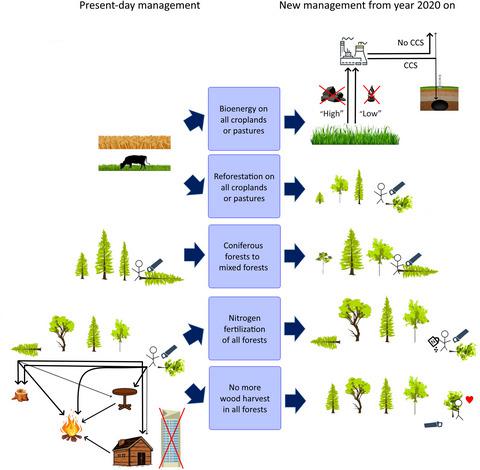当前位置:
X-MOL 学术
›
GCB Bioenergy
›
论文详情
Our official English website, www.x-mol.net, welcomes your feedback! (Note: you will need to create a separate account there.)
A regional assessment of land‐based carbon mitigation potentials: Bioenergy, BECCS, reforestation, and forest management
Global Change Biology Bioenergy ( IF 5.6 ) Pub Date : 2020-04-01 , DOI: 10.1111/gcbb.12675 Andreas Krause 1 , Thomas Knoke 1 , Anja Rammig 1
Global Change Biology Bioenergy ( IF 5.6 ) Pub Date : 2020-04-01 , DOI: 10.1111/gcbb.12675 Andreas Krause 1 , Thomas Knoke 1 , Anja Rammig 1
Affiliation

|
Land‐based solutions are indispensable features of most climate mitigation scenarios. Here we conduct a novel cross‐sectoral assessment of regional carbon mitigation potential by running an ecosystem model with an explicit representation of forest structure and climate impacts for Bavaria, Germany, as a case study. We drive the model with four high‐resolution climate projections (EURO‐CORDEX) for the representative concentration pathway RCP4.5 and present‐day land‐cover from three satellite‐derived datasets (CORINE, ESA‐CCI, MODIS) and identify total mitigation potential by not only accounting for carbon storage but also material and energy substitution effects. The model represents the current state in Bavaria adequately, with a simulated forest biomass 12.9 ± 0.4% lower than data from national forest inventories. Future land‐use changes according to two ambitious land‐use harmonization scenarios (SSP1xRCP2.6, SSP4xRCP3.4) achieve a mitigation of 206 and 247 Mt C (2015–2100 period) via reforestation and the cultivation and burning of dedicated bioenergy crops, partly combined with carbon capture and storage. Sensitivity simulations suggest that converting croplands or pastures to bioenergy plantations could deliver a carbon mitigation of 40.9 and 37.7 kg C/m2, respectively, by the year 2100 if used to replace carbon‐intensive energy systems and combined with CCS. However, under less optimistic assumptions (including no CCS), only 15.3 and 12.2 kg C/m2 are mitigated and reforestation might be the better option (20.0 and 16.8 kg C/m2). Mitigation potential in existing forests is limited (converting coniferous into mixed forests, nitrogen fertilization) or even negative (suspending wood harvest) due to decreased carbon storage in product pools and associated substitution effects. Our simulations provide guidelines to policy makers, farmers, foresters, and private forest owners for sustainable and climate‐benefitting ecosystem management in temperate regions. They also emphasize the importance of the CCS technology which is regarded critically by many people, making its implementation in the short or medium term currently doubtable.
中文翻译:

对陆地碳减排潜力的区域评估:生物能源,BECCS,重新造林和森林管理
陆地解决方案是大多数减缓气候变化方案必不可少的功能。在这里,我们通过运行一个生态系统模型来对区域碳减排潜力进行新颖的跨部门评估,作为案例研究,该模型可以明确表示德国巴伐利亚州的森林结构和气候影响。我们使用四个高分辨率气候预测(EURO-CORDEX)来驱动该模型,以用于代表浓度路径RCP4.5和来自三个卫星衍生数据集(CORINE,ESA-CCI,MODIS)的当前土地覆盖,并确定总体缓解措施不仅考虑碳存储,还考虑材料和能量替代效应。该模型充分代表了巴伐利亚州的当前状态,模拟的森林生物量比国家森林清单数据低12.9±0.4%。根据两种雄心勃勃的土地利用协调方案(SSP1xRCP2.6,SSP4xRCP3.4),未来的土地利用变化将通过植树造林以及专用生物能源作物的种植和燃烧实现206和247 Mt C的缓解(2015–2100年),部分与碳捕集与封存相结合。敏感性模拟表明,将耕地或牧场转换为生物能源种植园可减少40.9和37.7 kg C / m的碳如果用于取代碳密集型能源系统并与CCS结合使用,则到2100年分别达到2。但是,在不那么乐观的假设下(不包括CCS),只能减少15.3和12.2 kg C / m 2,重新造林可能是更好的选择(20.0和16.8 kg C / m 2)。由于产品库中碳储量的减少和相关的替代效应,现有森林的减缓潜力有限(将针叶林转变为混交林,施氮)或什至是负面的(森林砍伐)。我们的模拟为温带地区的决策者,农民,林业者和私有林所有者提供了可持续的,有利于气候的生态系统管理的指南。他们还强调了CCS技术的重要性,这一技术已被许多人批评,这使其在短期或中期的实施目前令人怀疑。
更新日期:2020-04-01
中文翻译:

对陆地碳减排潜力的区域评估:生物能源,BECCS,重新造林和森林管理
陆地解决方案是大多数减缓气候变化方案必不可少的功能。在这里,我们通过运行一个生态系统模型来对区域碳减排潜力进行新颖的跨部门评估,作为案例研究,该模型可以明确表示德国巴伐利亚州的森林结构和气候影响。我们使用四个高分辨率气候预测(EURO-CORDEX)来驱动该模型,以用于代表浓度路径RCP4.5和来自三个卫星衍生数据集(CORINE,ESA-CCI,MODIS)的当前土地覆盖,并确定总体缓解措施不仅考虑碳存储,还考虑材料和能量替代效应。该模型充分代表了巴伐利亚州的当前状态,模拟的森林生物量比国家森林清单数据低12.9±0.4%。根据两种雄心勃勃的土地利用协调方案(SSP1xRCP2.6,SSP4xRCP3.4),未来的土地利用变化将通过植树造林以及专用生物能源作物的种植和燃烧实现206和247 Mt C的缓解(2015–2100年),部分与碳捕集与封存相结合。敏感性模拟表明,将耕地或牧场转换为生物能源种植园可减少40.9和37.7 kg C / m的碳如果用于取代碳密集型能源系统并与CCS结合使用,则到2100年分别达到2。但是,在不那么乐观的假设下(不包括CCS),只能减少15.3和12.2 kg C / m 2,重新造林可能是更好的选择(20.0和16.8 kg C / m 2)。由于产品库中碳储量的减少和相关的替代效应,现有森林的减缓潜力有限(将针叶林转变为混交林,施氮)或什至是负面的(森林砍伐)。我们的模拟为温带地区的决策者,农民,林业者和私有林所有者提供了可持续的,有利于气候的生态系统管理的指南。他们还强调了CCS技术的重要性,这一技术已被许多人批评,这使其在短期或中期的实施目前令人怀疑。


























 京公网安备 11010802027423号
京公网安备 11010802027423号